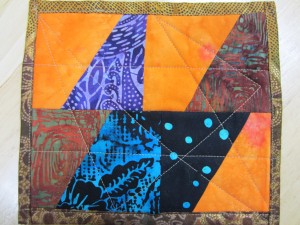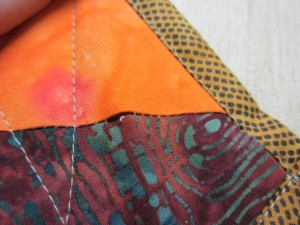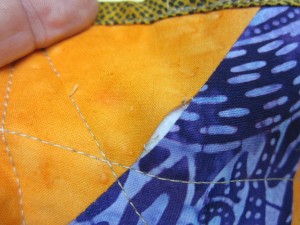Is there a big difference between quilt seams that are pressed open and those pressed to one side? Let me show you what I found.
I have always heard that a seam pressed to one side is stronger than one pressed open. It kind of makes sense, but does it matter? With many modern quilters promoting pressing seams open, I felt compelled to test the theory.
I made this 6″ x 9″ quilt sample (pictured right), half with seams pressed open and half with seams pressed to one side. Note that there are some seams that are with the grain of fabric and others that are bias, but not as bias as possible.
Then I pulled and tugged on opposite sides, opposite corners, and any other way possible to mimic “using” the quilt. Stitches broke as I would have expected though only on the diagonal seams and diagonal quilting.
Here is how the broken stitches look on the part with seams pressed to one side (pictured left).
Not too bad. It did not get much worse with more pulling and tugging.
Here are what the broken stitches look like on the seam pressed open (pictured right).
Wow! That is a lot of batting showing. And it opened up significantly when I stretched and pulled even more. Also, there were more breaks in these seams than there were in the seams that were pressed to one side.
So with this quick test, I KNOW which way my seams are going.
If you have not given it much thought, here are the pros and cons that I know and have heard about each type of seam.
Seams pressed to one side:
- Simple enough to press (especially if using flannel on the ironing board)
- Seams lock (butt up against each other for easy matching of points without pinning)
- 2.5 mm stitch length is reasonable (10 stitches per inch)
- Allows stitch-in-the-ditch quilting for quilting lines that are functional but not visible (to me this quilting style requires time, patience, and skill so I only use it when necessary)
- Appears that this seam is stronger (I used cotton thread, but I know polyester will also break with the stretch of a bias seam. That is why in garment sewing, the curved seams that have the most stress or tension are double stitched, trimmed, and not pressed open.)
- Seams can be bulky where many fabrics come together making it difficult for quilting and may wear faster at that point (there are easy methods for flattening these points)
- Shadowing caused by seams pressed one way add depth and dimension that is part of the feel of a traditional quilt
Seams pressed open:
- Seams are flatter and do not create dimension to the overall design. (Desirable for miniatures and wall hangings)
- Intersections are not as bulky because seams are pressed open and seam allowances are evenly distributed.
- Seams flow through some machines more easily because the layers are pinned and not as likely to shift because the number of layers is same throughout without shifting from top to bottom fabric. (Requires pinning for points to match)
- Can be challenging to press seams open. Using a dowel or pressing sleeve or other tool makes it more readily accomplished.
- Use a smaller stitch to accommodate bias seams. (Takes more time to stitch the seam and harder to seam rip when needed.)
- Stitch-in-the-ditch is not an option for quilting, so the quilting will have to show.
Hopefully my thoughts and research on the subject will help you make an informed decision as to when you want seams pressed to one side and when you want seams pressed open. Each method has valid reasons. Knowing what makes sense for your project will help you be more confident in your work and help you achieve long-lasting, desired results.
Marci





Leave a Reply
You must be logged in to post a comment.